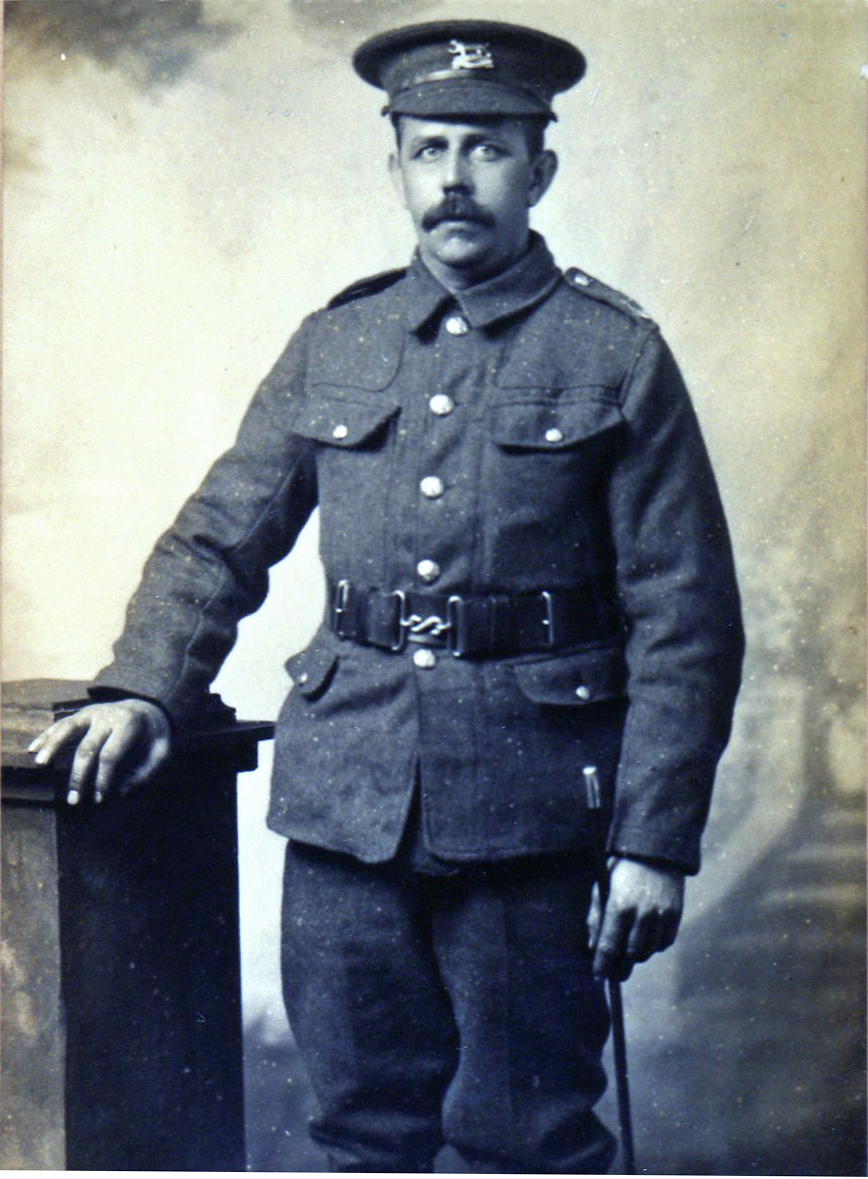William Palmer
View William on the Commonwealth War Graves Commission website
Known information
Private William Palmer was the fourth child of waggoner William and Eliza Palmer of Langham and was born on 7 May 1880 in Langham. As a young man he left Langham to work in Kibworth and there he met and fell in love with Emma Sturgess of Great Weldon in Northamptonshire. They were married in 1903 and moved back to Langham where William worked on the Ranksborough estate for Colonel Brocklehurst who later became Lord Ranksborough and Rutland's Lord Lieutenant. They lived on Cold Overton Road in Langham and had seven sons, one of whom died as the result of a bicycle accident when he was six years old. William was a well known villaager serving on several committees and when a recruiting campaign came to the village in the spring of 1915 he was the only volunteer and enlisted in the Leicestershire Regiment. His grand-daughter Ann Grimmer takes up the story: "He believed that because of his age of 35 years he would be working in some capacity behind the lines but of course he was eventually needed to fight and he lost his life on 3 May 1917, just four days before his 37th birthday. His attestation papers record the fact that he had already served three years with the 1st Volunteer Battalion Leicestershire Regiment and after innoculations he was posted to France in the autumn of 1916 to prepare for the next big offensive. In November 1916 the British had begun preparations for a surprise spring offensive on the Hindenburg Line by extending the old chalk quarries under Arras to accommodate up to 24,000 soldiers and this work was done by 500 miners from the New Zealand Tunnelling Company assisted by miners from the Royal Engineers. Being a member of the 8th Battalion Leicestershire Regiment, William would have been one of those 24,000 soldiers secretly hidden in the underground barracks in the limestone caves for the week before the beginning of the Battle of Arras. The war diaries for 1 May 1917 record that the battalion was bivouacked to the north of the village of Fontaine les Croisilles and on the night of the 1/2 May the 110th Infantry Brigade took over the positions of the 64th Infantry Brigade north of the Hindenburg Line. The 8th Battalion Leicestershire Regiment was in the support line in the Brown Trench forming the right supporting battalion, and the 9th Battalion Leicesteshire Regiment in the Curtain Trench formed the left assaulting battalion, with the 7th Battalion Leicestershire Regiment in reserve. On 3 May 1917 the diaries tell of the attack on the village of Fontaine les Croisilles - there were three objectives on the Sensee river, the junction of the Sensee river and the Sunken Road and thence round the eastern edge of Fontaine to the 3rd Army boundary. Zero hour was 3.45am; the morning was very dark and sunrise was not until 5.23am, the dust and smoke from the British creeping barrage and the German artillery made it impossible to see more than a few yards ahead. By 6.30am it was becoming evident that the attack would fail and they were outflanked and in parts surrounded and with the prospect of being cut off. Later in the morning they were reinforced and held the line for the rest of the day. No assistance had been given by the two tanks as both had broken down. During the action the battalion suffered over 100 casualties and over 200 were missing or dead, William being one of them. My father was William's youngest son and was only three years old at the time and the only memory he could recall of his father was sitting on the knee of a man in uniform and being given a sweet, most likely when his father was on leave before leaving for France. He was nearly 5 years old when the news came that his father was "missing, presumed dead" and well remembered his distraught mother and the upset within the family." William Palmer is commemorated on bay 5 of the Arras memorial and on the war memorial at Langham. His son Arthur Reginald Palmer, known as Reg, died in the Second World War from pneumonia after seeing action in Norway and being interned in Sweden. He is buried in Oakham cemetery with a CWGC headstone.
Information and photograph courtesy Ann Grimmer.

|
Do you know something about William that hasn't been mentioned? You can add any new information and images as a contribution at the bottom of this page. |












.png)


.jpg)





Please wait